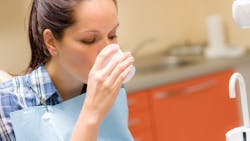Chlorhexidine—the good, the bad, and the ugly
When you hear the word chlorhexidine, these things probably come to mind:
- “It stains.”
- “A great killer of bacteria.”
- “Has poor patient compliance.”
- “Works well … but causes calculus.”
- “Tastes terrible.”
- “Adds a lot more work.”
Given these characteristics, it’s no surprise clinicians generally fall into two camps on chlorhexidine. There are those who hate it and refuse to use it, and there are those who use it and choose to overlook the side effects. For the clinicians who use it, if we asked why, they probably wouldn’t say, “Because I love it!” Instead, they’d likely say things such as “There’s no alternative” or “I use it because it’s what I learned in school.” Yet, there is an alternative to chlorhexidine and, as most of us know, doing something just because you learned it in school isn’t always good enough.
For us to understand this controversial chemical’s place in dentistry, as well as possible alternatives, let’s take a hard look at chlorhexidine—the good, the bad, and the ugly.
The good: When used as designed
Chlorhexidine was introduced into dentistry in 1954 as a broad-spectrum biocide effective against gram-positive and gram-negative bacteria.1 It was designed to be used temporarily to help patients reverse gingivitis.
Chlorhexidine is a great bacterial killer. There is no need to debate this, as study after study has confirmed it. However, it requires an incredibly high concentration to achieve positive results: 1,200 parts per million.2 This is one of the reasons why chlorhexidine is not intended to be used longer than two weeks.
Related content:
I'm breaking up with you, chlorhexidine
Staff Rx: Preoperative rinsing
Even though chlorhexidine has many side effects, it can be safely used to treat gingivitis. However, many dental professionals use chlorhexidine off-label, and this is where the contraindications and safety concerns come into play.
The bad: Side effects
The main reason many clinicians dislike chlorhexidine is because of its side effects. We all know chlorhexidine stains teeth, and another common side effect is calculus buildup. Neither side effect is something you’d logically want for patients after their scalings, prophies, or surgeries.
Patients struggle to stay compliant with chlorhexidine because of the taste. They can’t rinse with water afterward because it renders the chlorhexidine ineffective. In fact, water actually increases the bitterness!3 After using, patients may complain of a “metallic” aftertaste that sticks around for several hours.4 Some patients even experience an alteration in taste.4 In rare instances, permanent taste alteration is experienced after the treatment has run its course.5
The ugly: Things you might not know
Side effects such as staining and calculus aren’t ideal, but they aren’t dangerous. Clinicians may be willing to compromise in an effort to get better treatment results. However, studies and real-world cases show us we may want to reconsider.
Even with the treatment of gingivitis, there are unrealistic instructions and expectations for patients to follow. Because chlorhexidine is easily inactivated, it should be used 30 minutes after other dental products. It is deactivated by anionic compounds, including the anionic surfactants used in toothpaste.6 So patients should not rinse immediately after brushing.6 Furthermore, they must then avoid drinking, eating, and smoking for at least one hour after use.
There is also information that states saliva and blood inactivate chlorhexidine.7,8 How do we avoid saliva in the mouth? We can’t. So does it really even make sense to use chlorhexidine at all?
The serious side effects of chlorhexidine also include its impact on fibroblast formation in the periodontal pocket. The most alarming findings date back to 1991, when Charles D. Alleyn, DDS, studied the reestablishment of lost connective tissue attachment to the root surface following periodontal therapy. Chlorhexidine was found to damage the fibroblasts, which are essential factors in reattachment,9 which is the purpose of scaling and root planing. Chlorhexidine disrupted the healing process, causing the healing phase to take longer and decreasing the likelihood of a favorable outcome with therapy.
Another study published in 2006 discussed the cytotoxic effect of chlorhexidine on cells and cautioned against using it following scaling and root-planing procedures (such as irrigation) due to its damaging cells that aid in the healing process (such as fibroblasts).10 A different study stated that the higher concentration (≥ 0.04%) of chlorhexidine inhibits cell proliferation and, to a certain extent, affects cell morphology. The study concluded that “the application of CHX in the post-surgical antiseptic treatment of the oral cavity should be limited.”11 (However, it should be noted in chlorhexidine’s defense that it was never meant to be used that way.)
Off-label uses of chlorhexidine are where many of the serious issues originate. It was not created to be used with implants, periodontal therapy, or oral surgery. The Food and Drug Administration has reported more than 52 cases of anaphylaxis between 1998 and 2010, and this number has been increasing.5 The serious cases involving allergic reactions reported outcomes that required emergency department visits or hospitalizations to receive drug and other medical treatments. Two of these cases actually resulted in death. In both scenarios, each patient had left the dental office after an extraction with instructions to use chlorhexidine rinse at home. As previously mentioned, it takes 1,200 ppm of chlorhexidine to achieve results.2 For this reason, it should not be used with open wounds. In the cases in which patients died, both had open wounds and the uptake of the active ingredient was too high, inducing severe allergic reactions.5
An alternative
Many dental professionals feel “the bad” and “the ugly” of chlorhexidine outweigh “the good,” leaving them in search of an alternative. More than 10 years ago, a group of dentists sharing this feeling decided to develop an alternative. After years of research and development, they came up with OraCare.
The active ingredient in OraCare, activated chlorine dioxide, kills the same bacteria as chlorhexidine but with only 44 ppm.2 Chlorine dioxide is a gas, so it dissipates through the tissues quickly and without lingering side effects. Taken together, these features make it safe for everyday use. In addition, activated chlorine dioxide has been shown to effectively remove biofilm, neutralize volatile sulfur compounds, and kill fungi and viruses.2
OraCare differentiates itself in that it leaves no stains, does not cause additional calculus buildup, and has no negative impact on fibroblasts. The most common uses for OraCare are for bleeding gums, periodontitis, implant maintenance, dry mouth, bad breath, and mouth sores.
While chlorhexidine is an effective killer of bacteria, its side effects and dangerous off-label usage open the door to safer and equally effective alternatives. If you are ready to make the switch, an alternative to chlorhexidine can help you provide “the good” and avoid “the bad” and “the ugly.”
Editor's note: Originally posted in 2020 and updated as of March 2025.
References
- Horner C, Mawer D, Wilcox M. Reduced susceptibility to chlorhexidine in staphylococci: is it increasing and does it matter? J Antimicrob Chemother. 2012;67(11):2547-2559. https://doi.org/10.1093/jac/dks284
- Downs R, Banas JA, Zhu M. An in vitro study comparing a two-part activated chlorine dioxide oral rinse to chlorhexidine. Perio-Implant Advisory. Published January 21, 2015 .https://www.perioimplantadvisory.com/clinical-tips/hygiene-techniques/article/16411500/an-in-vitro-study-comparing-a-twopart-activated-chlorine-dioxide-oral-rinse-to-chlorhexidine
- About chlorhexidine: Mechanism of action. 2019. chlorhexidinefacts.com/mechanism-of-action.html.
- Wyganowska-Swiatkowska M, Kotwicka M, Urbaniak P, et al. Clinical implications of the growth-suppressive effects of chlorhexidine at low and high concentrations on human gingival fibroblasts and changes in morphology. Int J Mol Med. 2016;37(6):1594-1600. doi/10.3892/ijmm.2016.2550
- FDA drug safety communication: FDA warns about rare but serious allergic reactions with the skin antiseptic chlorhexidine gluconate. U.S. Food & Drug Administration. Published February 9, 2017. https://www.fda.gov/drugs/drug-safety-and-availability/fda-drug-safety-communication-fda-warns-about-rare-serious-allergic-reactions-skin-antiseptic.
- Tsourounakis I, Palaiologou‐Gallis AA, Stoute D, et al. Effect of essential oil and chlorhexidine mouthwashes on gingival fibroblast survival and migration. J Periodontol. 2013;84(8):1211-1220.
- Salam M, Arslan U, Bozkurt B, Hakki SS. Boric acid irrigation as an adjunct to mechanical periodontal therapy in patients with chronic periodontitis: A randomized clinical trial. J Periodontol. 2013;84(9):1297-1308.
- van Maanen-Schakel NWD, Slot DE, Bakker EWP, Van der Weijden GA. The effect of an oxygenating agent on chlorhexidine-induced extrinsic tooth staining: a systematic review. Int J Dent Hyg. 2012;10(3):198-208. doi:10.1111/j.1601-5037.2012.00555.x
- Alleyn CD, O’Neal RB, Strong, SL, et al. The effect of chlorhexidine treatment of root surfaces on the attachment of human gingival fibroblasts in vitro. J Periodontol. 1991;62(7):434-438. doi/10.1902/jop.1991.62.7.434
- Polimeni G, Xiropaidis AV, Wikesjö UME. Biology and principles of periodontal wound healing/regeneration. Periodontol 2000. 2006;41:30-47.
- Wyganowska-Swiatkowska M, Kotwicka M, Urbaniak P, et al. Clinical implications of the growth-suppressive effects of chlorhexidine at low and high concentrations on human gingival fibroblasts and changes in morphology. Int J Mol Med. 2016;37(6):1594-1600. doi.org/10.3892/ijmm.2016.2550
About the Author
Kristin Goodfellow, RDH
Kristin Goodfellow, RDH, is the chief clinical officer for OraCare, a dental products company dedicated to improving the standard of care. She completed her dental hygiene degree at Allegany College of Maryland and obtained a Bachelor of Arts degree in communication studies from West Virginia University. She serves as a senior executive consultant for Cellerant, a member of the Best of Class Hygiene committee, and a liaison to seven dental practices in West Virginia. She utilizes her communication, dentistry, and leadership skills to integrate new protocols that promote optimal patient care.
Updated April 5, 2023

